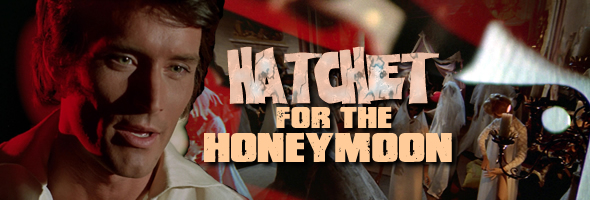

Color, 1970, 88m. Still running the fashion house inherited from his mother, John Harrington (Forsyth, channeling John Phillip Law) has no qualms with the fact that he's insane. Tormented by hazy memories of his mom's violent death, he can only remember additional details by bumping off young women and tossing their bodies into the hot house on his property. Fortunately his specialty is wedding dresses and he has a steady supply of female employees on the payroll, all of whom eventually want to leave their job to get married. That leaves John the opportunity to discreetly let his inner lunatic out and dispatch of his disloyal employees with a meat cleaver, inching him closer to the revelation he craves. Standing in his way is his nagging wife, Mildred (Bay of Blood's Betti), who refuses to grant him a divorce. As the police begin to suspect that something might be amiss within the Harrington household, John goes to even more extreme lengths to deal with his inner demons.
Bava's first bona fide horror film since 1966's Kill, Baby! Kill! (which proved to be his farewell to period horror films), Hatchet for the Honeymoon (originally released in Italy as Il rosso sengo della folia or "The Red Sign of Madness") falls squarely in line with the fragmented, playful pop-art films the director made immediately before and after (especially Danger: Diabolik and Four Times That Night), even if its tone and themes are definitely more in line with his earlier horror classics
The film is also blessed with a wonderfully wry performance by Betti, an actress better known for her prestige roles in films for Pier Paolo Pasolini and Bernardo B
Barely released theatrically in any territories around the world, Hatchet for the Honeymoon accidentally became one of Bava's most omnipresent films thanks to distribution loopholes placing it more or less in the public domain. That meant a slew of VHS and DVD releases over the years, only a tiny handful of which were actually worth seeing. A barely letterboxed, non-anamorphicDVD came early in the game from Image Entertainment as one of the few non-Alfredo Leone titles in its Bava release line, taken from a pretty battered theatrical print with mediocre detail levels and acceptable but
While American audiences were deprived of a worthwhile release of this title for decades, that oversight has been thankfully remedied with the 2012 Blu-Ray (and simultaneous DVD reissue) of the film from Kino Lorber under the banner of Redemption Films. Apparently taken from the same negative given the same color palette and minimal signs of wear, it definitely eclipses its standard def counterparts and confirms Bava's status as one of the best "eye candy" directors out there who could also deliver satisfaction for the mind as well. In lieu of the prior Tim Lucas liner notes, we have here an entire new audio commentary by him that fills in far more of the gaps about its creation. Given the delays that surrounded the film's release (apparently it was shot just before Four Times That Night with pre-production beginning in 1968), its official release date and placement within Bava's filmography has often been a bit sketchy. Here he covers the circumstances of the production, its Spanish financial ties and shooting locations, the bizarre decision to set the story in Paris and then excise most of the relevant location footage, the blink-and-you'll-miss-it appearance by genre vet Luciano Pigozzi, and the acrimonious relationship between Betti and actress Dagmar Lassander, who was originally intended to be the female lead. He also has to navigate through an unusually tricky minefield of both Spanish and Italian names, keeping things moving along quite smoothy. Definitely recommended listening, and along with the substantial uptick in quality for the feature itself, this ranks as a very promising early entry in the HD history of one of the genre's most inventive filmmakers.
Directed by Mario Bava
Starring Stephen Forsyth, Laura Betti, Dagmar Lassander, Femi Benussi, Jesus Puente
Kino Lorber (Blu-Ray & DVD) (US RA/R1 HD/NTSC), Anchor Bay (UK R0 PAL), Koch (Germany R2 PAL) / WS (1.78:1) (16:9), Image (US R1 NTSC) / WS (1.70:1), and numerous public domain labels
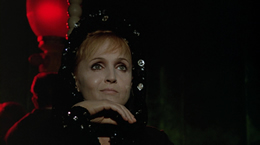 Sort of a cross between the murderous and supernatural relationship hell of The Whip and the Body and the giallo-friendly fashion salon world of Blood and Black Lace, this tricky psychedelic-era offering from director Mario Bava has long been one of his most widely available yet misunderstood titles. Viewers expecting a relentless gorefest thanks to that title are usually surprised to get a psychological study of a handsome and wildly dysfunctional murderer giving a first-person account of his attempt
Sort of a cross between the murderous and supernatural relationship hell of The Whip and the Body and the giallo-friendly fashion salon world of Blood and Black Lace, this tricky psychedelic-era offering from director Mario Bava has long been one of his most widely available yet misunderstood titles. Viewers expecting a relentless gorefest thanks to that title are usually surprised to get a psychological study of a handsome and wildly dysfunctional murderer giving a first-person account of his attempt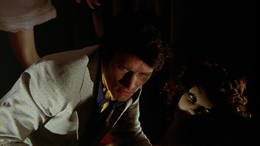 s to grapple with his impulses... not to mention his problems with a scolding wife whose persistence leaves most of her cinematic counterparts in the dust.
s to grapple with his impulses... not to mention his problems with a scolding wife whose persistence leaves most of her cinematic counterparts in the dust.
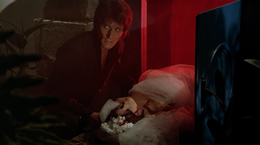 mentioned above. Rather than spraying the screen with blood, Bava douses it with an array of wild lighting effects, distorted textures, and audacious in-camera visual tricks, the most astonishing involving the cleaver literally hacking a scream and the screen itself in half.
mentioned above. Rather than spraying the screen with blood, Bava douses it with an array of wild lighting effects, distorted textures, and audacious in-camera visual tricks, the most astonishing involving the cleaver literally hacking a scream and the screen itself in half.
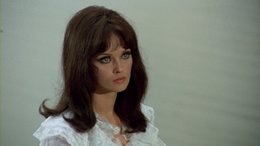 ertolucci, and the much-maligned Forsyth is actually rather effective as a soulless pretty boy whose internal monologues send him spinning in homicidal circles. Bava's streak of getting top-notch film scores from a diverse range of composers continues here thanks to a lyrical and sometimes wildly experimental and frug-worthy score by Sante Maria Romitelli, who of course went on to film score infamy with his disco-charged work on Yeti - Giant of the 20th Century. At the time, the idea of mixing black humor and horror in a Bava film seemed like an odd concept, though he would later prove this was no fluke in Five Dolls for an August Moon and especially the pitch-black, proto-slasher gags in Bay of Blood. The winks at the audience here range from our anti-hero's befuddled reactions to the increasingly bizarre chain of events unleashed by his murders to the unforgettable moment when a homicide is covered up by a TV screening of Bava's own Black Sabbath!
ertolucci, and the much-maligned Forsyth is actually rather effective as a soulless pretty boy whose internal monologues send him spinning in homicidal circles. Bava's streak of getting top-notch film scores from a diverse range of composers continues here thanks to a lyrical and sometimes wildly experimental and frug-worthy score by Sante Maria Romitelli, who of course went on to film score infamy with his disco-charged work on Yeti - Giant of the 20th Century. At the time, the idea of mixing black humor and horror in a Bava film seemed like an odd concept, though he would later prove this was no fluke in Five Dolls for an August Moon and especially the pitch-black, proto-slasher gags in Bay of Blood. The winks at the audience here range from our anti-hero's befuddled reactions to the increasingly bizarre chain of events unleashed by his murders to the unforgettable moment when a homicide is covered up by a TV screening of Bava's own Black Sabbath!
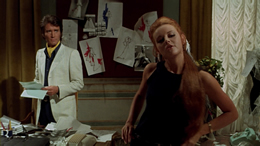 hardly breathtaking colors. As with numerous other video versions, the soundtrack also tended to distort during louder moments (especially the music), though this was still far preferable to the dupey, VHS-derived versions unleashed by budget labels. As with the other Image releases, this one contained solid liner notes by Tim Lucas, who laid out the basics about a film that was, at the time, something of an enigma in the composer's filmography. A vastly superior anamorphic transfer from the original negative arrived a few years later from Koch in Germany, with a rich and very satisfying color scheme and accurate 1.85:1 framing. The trailer was the only extra, but the subsequent Anchor Bay UK version (from the s
hardly breathtaking colors. As with numerous other video versions, the soundtrack also tended to distort during louder moments (especially the music), though this was still far preferable to the dupey, VHS-derived versions unleashed by budget labels. As with the other Image releases, this one contained solid liner notes by Tim Lucas, who laid out the basics about a film that was, at the time, something of an enigma in the composer's filmography. A vastly superior anamorphic transfer from the original negative arrived a few years later from Koch in Germany, with a rich and very satisfying color scheme and accurate 1.85:1 framing. The trailer was the only extra, but the subsequent Anchor Bay UK version (from the s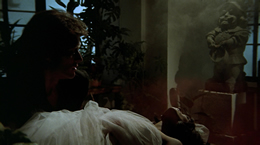 ame master but less carefully compressed) added on the one-hour Mario Bava: Maestro of the Macabre special (with Mark Kermode commentary on all but the erroneous first pressing), a gallery, and some minor text extras to sweeten the deal.
ame master but less carefully compressed) added on the one-hour Mario Bava: Maestro of the Macabre special (with Mark Kermode commentary on all but the erroneous first pressing), a gallery, and some minor text extras to sweeten the deal.
Reviewed on September 12, 2012.
![]()